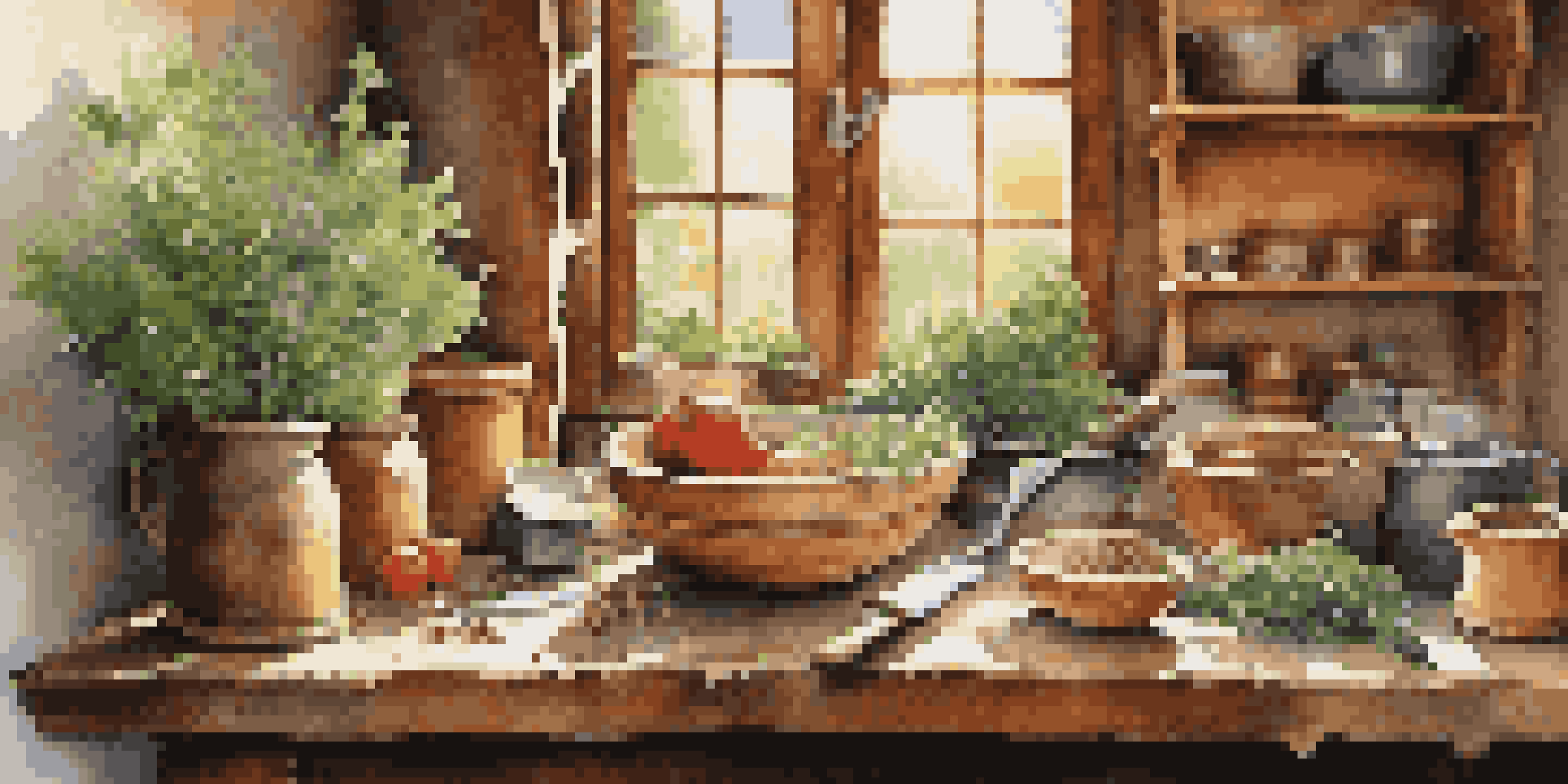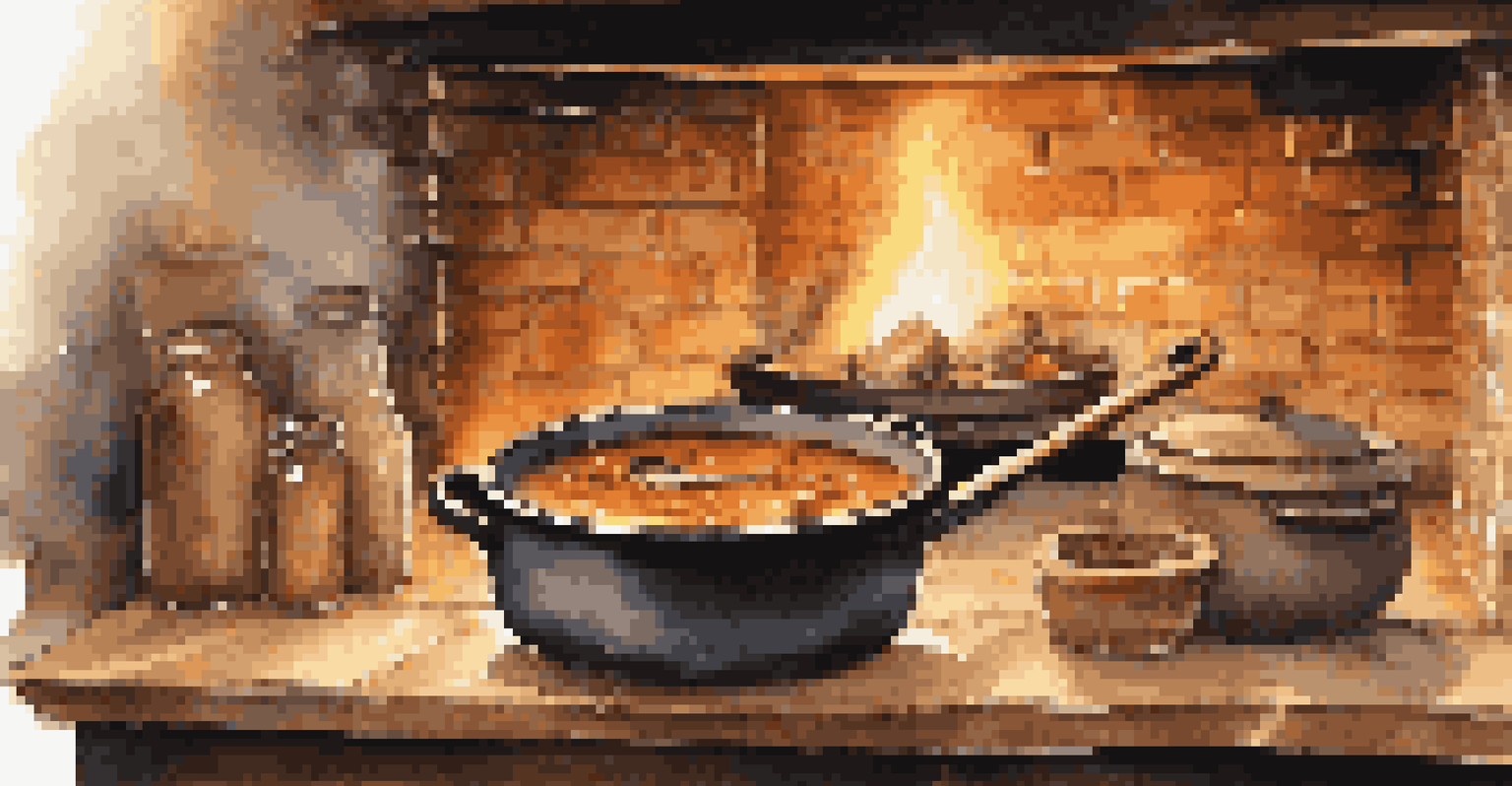Historical Cooking Tools: Recreating Recipes with Authentic Gear

The Allure of Cooking with Historical Tools
Using historical cooking tools can transport you back in time, adding a unique dimension to your culinary adventures. Imagine the satisfaction of preparing a meal with the same tools that our ancestors used, from hand-forged knives to clay pots. These tools not only enhance the cooking process but also connect us to the rich tapestry of human history.
Cooking is like love. It should be entered into with abandon or not at all.
When you cook with these authentic implements, you engage in a form of storytelling. Each tool has its own history and purpose, reflecting the culture and resources of the time it originated from. This connection to the past can make the cooking experience more meaningful and enjoyable.
Moreover, the tactile experience of using a wooden spoon or a cast-iron skillet can remind us of the simplicity and beauty of traditional cooking methods. In an age dominated by modern gadgets, these historical tools encourage us to slow down and savor the process of making food.
Essential Historical Cooking Tools to Consider
To embark on your journey into historical cooking, you'll want to start with a few essential tools. A mortar and pestle, for example, is perfect for grinding herbs and spices, allowing you to experience the flavors of the past in a whole new way. Similarly, a wooden butter churn can transform cream into rich butter, connecting you with centuries of culinary tradition.

Don't overlook the importance of cast-iron cookware, which has been a staple in kitchens for generations. Its ability to retain heat and develop a natural non-stick surface over time makes it ideal for a variety of recipes. Plus, these pans can last a lifetime if cared for properly, making them a sustainable choice for modern cooks.
Historical Tools Enhance Cooking
Using historical cooking tools connects us to our culinary heritage and enriches the cooking experience.
Lastly, consider investing in a Dutch oven or a clay cooking vessel. These pots are excellent for slow-cooking stews and soups, drawing out deep, rich flavors that are hard to replicate with modern cookware. Each of these tools adds a touch of authenticity to your kitchen and enhances your cooking experience.
Exploring Historical Recipes and Their Significance
Recreating historical recipes is like opening a time capsule, revealing the flavors and ingredients of a bygone era. Many traditional recipes were passed down through generations, often reflecting the available resources and cultural practices of the time. By exploring these recipes, you can gain insight into how people lived and ate in different historical contexts.
The kitchen is a place of adventure and experimentation, where the past meets the present.
For instance, making a Victorian-era meat pie or a medieval bread recipe can provide a fascinating glimpse into the diets of our ancestors. These dishes often utilize ingredients that may be unfamiliar today, encouraging you to expand your palate and discover new flavors. Plus, recreating these meals can be a fun way to engage with family and friends, sparking conversations about history and culture.
Additionally, cooking historical recipes can inspire you to consider food sustainability and seasonality. Many of our ancestors relied on what was available locally and in season, a practice that is increasingly relevant in today's world. Embracing these recipes can help cultivate an appreciation for local ingredients and traditional cooking methods.
Gathering Ingredients: Embracing Historical Practices
When preparing historical recipes, sourcing ingredients can be an adventure in itself. Many historical dishes feature local or seasonal ingredients that might not be readily available in modern supermarkets. This challenge can lead you to local farmers' markets, specialty shops, or even your own backyard for fresh herbs and vegetables.
Consider researching heirloom varieties of fruits and vegetables that were popular in the past. For example, heirloom tomatoes or ancient grains like spelt can add a unique twist to your dishes and enhance authenticity. Experimenting with these ingredients not only supports biodiversity but also connects you to agricultural traditions.
Explore Recipes for Cultural Insight
Recreating historical recipes allows us to discover past flavors and understand the cultural significance of food.
Additionally, don't hesitate to explore foraging as a way to gather ingredients. Many historical recipes include wild herbs, berries, and mushrooms that were commonly found in nature. Embracing these practices can deepen your understanding of food sources and foster a greater connection to the environment.
The Art of Cooking: Techniques from the Past
Cooking techniques have evolved over centuries, but many traditional methods still hold value today. Techniques like slow roasting, fermenting, and pickling were used by our ancestors to preserve food and enhance flavors. Rediscovering these methods can add depth and character to your cooking.
For example, fermenting vegetables not only preserves them but also introduces beneficial probiotics that can enhance gut health. This practice harkens back to ancient civilizations that relied on fermentation for food preservation. By incorporating these techniques, you not only honor history but also boost the nutritional value of your meals.
Furthermore, techniques like open-fire cooking or baking in a wood-fired oven can impart unique flavors that are hard to replicate with modern appliances. Embracing these methods allows you to connect with the elemental nature of cooking, transforming it into a more immersive and rewarding experience.
Connecting with Community Through Historical Cooking
One of the joys of historical cooking is the opportunity to connect with others who share your passion. Joining cooking classes or workshops focused on historical techniques can foster a sense of community and provide valuable hands-on experience. These gatherings often become a space for sharing stories, recipes, and culinary tips.
You might also consider hosting a historical cooking night with friends or family, where everyone can contribute a dish from the past. This not only makes for a memorable gathering but also encourages everyone to engage in discussions about the history behind the recipes. Sharing food is a powerful way to bond and create lasting memories.
Community Through Cooking Together
Engaging in historical cooking fosters community connections and shared experiences around food and tradition.
Furthermore, online communities and social media platforms are great resources for finding like-minded individuals interested in historical cooking. From recipe exchanges to discussions about tools and techniques, these platforms can help you build connections and inspire creativity in the kitchen.
Preserving the Legacy of Historical Cooking Tools
As you immerse yourself in historical cooking, it's essential to consider how to preserve the legacy of these tools and techniques. Many historical cooking tools are at risk of being forgotten in our fast-paced, modern world. By using and caring for these tools, you contribute to their legacy and help keep traditional cooking alive.
Engaging in conversations about historical cooking can also raise awareness about its importance. Sharing your experiences with family, friends, and the online community helps spark interest and appreciation for these time-honored practices. You might even inspire someone else to pick up a historical tool or try a traditional recipe.

Finally, consider supporting local artisans who create historical cooking tools. By purchasing handmade items, you not only acquire unique kitchen gear but also contribute to the preservation of artisanal craftsmanship. This commitment to authenticity and quality ensures that future generations can continue to enjoy the beauty of historical cooking.